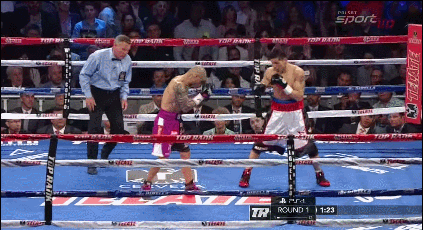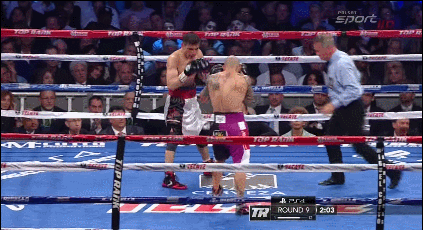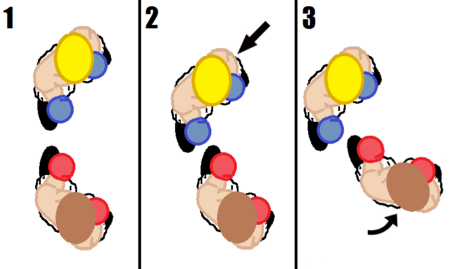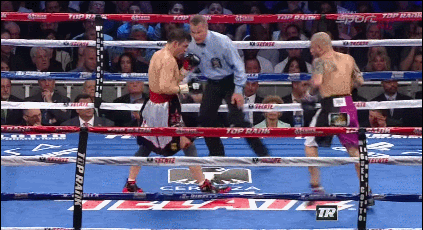Continuing on...
You see, Martinez is used to a certain distance against orthodox fighters. They step to his right, and he makes a small turn and puts them right back where they started. By placing his foot to the inside of Martinez's, Cotto placed himself closer to the champion's chin than he realized, and caught him repeatedly as he tried in vain to counter.
Let's see two more examples of this same hook later in the round.
At 1:19 of the round, Cotto steps in, eschewing the jab this time and opting to lead with the hook. This is fine, as the jab has already done its work, establishing a clear route to Martinez's center line, something the champion is clearly unprepared to deal with. Again Martinez tries to counter, looking very hesitant on the trigger. While some of this is likely a result of the knockdown earlier in the round, we cannot overlook the effect that Cotto's footwork had on Martinez's usually impeccable timing. With Cotto inside his stance, his habitual left pivot, which normally creates plenty of space and a strong angle from which to punch, now leaves him well within the path of the Puerto Rican's hook. At 1:05, Cotto actually cuts so dramatically to Martinez's left that he nearly turns his back, but by closing the distance he is able to smother Martinez's counters while landing his own punches.
This is why I contend that the hook is the power punch to use against southpaws. For the reasons stated above, southpaw boxers are accustomed to fighting at very long distances, usually dominating just on the edge of jab range. From there, the right hand of an orthodox fighter has quite a gap to cover, making it relatively easy to avoid. The hook, on the other hand, is automatically closer to the target from the start. In addition, many southpaws struggle to see it coming over their own lead shoulder, making it a potent knockout blow.
To his credit, Martinez did begin to adjust. By the later rounds, after being rocked throughout the fight, he started slowly to catch on to Cotto's hook, moving away from it preemptively and covering up or ducking under it when he sensed it coming. However, Cotto can adapt as well, and he began mixing up his left hand punches to catch the champion off-guard.
Here, in the final round of the fight, Martinez steps outside Cotto's left foot and leads with a left hand. Cotto deftly slips the punch and immediately counters. Martinez senses the right hook coming and lowers his head, shelling up behind his gloves, but Cotto picks his punches perfectly. A short right hand convinces Martinez to peek out from behind his guard, and Cotto snaps his head back with a left uppercut. Again, Cotto is well positioned to the inside of Martinez's right foot, body more or less facing his opponent dead-on. From this position, Martinez simply cannot circle away from Cotto's left hand fast enough.
It's possible that Martinez, always more natural athlete than technical boxer, came into the fight unaware that an orthodox fighter could use his favorite tricks against him. That's precisely what Cotto did. Above, Martinez tries to create the angle for his left hand by stepping outside Cotto's left foot, but all it takes is a small shift on Cotto's part to turn this into a dominant angle for himself.
So what about the traditional strategy, then? The outside angle may be overrated, but is it useless?
Countering a southpaw's outside step with a pivot to the inside angle.
Absolutely not. In fact, it is by exploiting the inside angle that orthodox fighters can force crafty southpaws into giving up that angle they're normally so good at avoiding. Once Cotto had established that he was thoroughly capable of thrashing Martinez from the inside angle, Martinez became preoccupied with preventing it, fighting constantly to get his foot to the inside of Cotto's and turning his body to protect his centerline. In doing so, however, he handed Cotto the sought-after outside angle, and Cotto was all to willing to take it.
Here, Cotto jabs, stepping past Martinez's right foot this time and angling his body for a right hand. Martinez, oversensitive to Cotto's repeated attempts at the inside angle, turns his right foot in and jabs, trying to reestablish that position for himself. Unfortunately, he ends up overcompensating and Cotto is easily able to roll under his jab and step off-line with a short right hand. With his body turned away to his left, Martinez has no way to stop Cotto stepping to his right.
Cotto exerted tremendous metnal pressure on Martinez throughout this fight, pushing the Argentine early, catching him with heavy punches from the get-go, and then punishing him for every successful adjustment. If nothing else, this fight should emphasize the impact of Freddie Roach on Miguel Cotto's fighting, as the well-traveled (and periodically lost) boxer was never without an answer against one of the craftiest men in the sport, injury or no. Simply put, this was a clinic, and Miguel Cotto is a very thorough teacher.
The End
 |
|

 Thanks:
Thanks:  Likes:
Likes:  Dislikes:
Dislikes: 






 Reply With Quote
Reply With Quote
Bookmarks